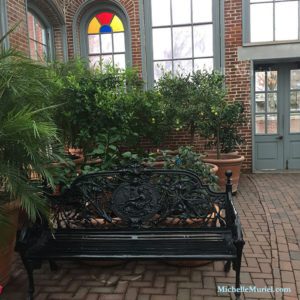

Today, Feathered Quill reviewer Lynette Latzko is talking with Michelle Muriel, the author of Water Lily Dance
FQ: The great impressionist Claude Monet and his famous paintings of waterlilies are featured in this historical fiction novel. What motivated you to write a story revolving around this particular artist?

MURIEL: As in my debut novel, Essie’s Roses, and now in Water Lily Dance, I revisit my favorite subject: freedom and the courage to fight for its many forms. When young Claude Monet set out to paint his goal wasn’t to change the world. Monet desired to paint the truth of what he saw using his technique and not the classical ideal or how and what others demanded. That is powerful when you understand the mandates and expectations of Paris 1865 placed on artists. An artist faced government censorship and slammed doors at earning a living when they deviated from tradition and mandates. Yet, a group of painters (the Impressionists) dared to pave the way for free expression. That is what attracted me to Claude Monet’s beginning, his famous friends, and the young woman in the middle of it all: Camille.
FQ: One of the themes in Water Lily Dance is love and loss. Have you ever experienced anything similar?
MURIEL: Sophie’s Journey: After the death of my mom, a casualty to a national drug shortage for a chemotherapy drug to extend her life she could not get, I had to follow my heart and write this novel as a dedication to her. I decided to share my experience with loss, the secret side of grief between daughters as caretakers and mothers with end-of-life secrets and wishes. My mom was a 1960s wife who dreamed of becoming an artist, but she set that dream aside to raise her children. Though she never realized her dream, art resided in her soul, art, and creativity she gifted to her children. And so, for a few pages, my mom was a famous artist: Josephine de Lue. Sophie’s Journey is one from my heart to my readers and offers a massive dose of hope.
A line in Water Lily Dance from one of my favorite characters, Annabel, spoke healing to my own loss: “We do not move on from grief; we move through it.” That is the magic of writing when whispers appear on the page that soothe my soul.

FQ: Historical fiction is a good blend of imagination and truth wrapped up in one story. What were the steps in your research to make this novel's historic details accurate?
MURIEL: When I started writing Water Lily Dance, I had no idea the monumental task of research required regarding the birth of Impressionism, its many artists, their "new" Paris, and the lives of a trailblazing couple surrounded by famous friends and patrons. Because Monet spoke little about his upbringing and often exaggerated facts, the only way to truly know young Claude Monet was to study his famous friends and letters as Auguste Renoir, Frédéric Bazille, Émile Zola, Alexandre Dumas, Gustave Courbet, even a wealthy French code breaker in the military, and other celebrities of the day. I consulted several online catalogs, art museum archives, auction house records, numerous books, 19th-century French documents, and letters regarding the history of Monet and his friends.
And there was Camille, a mysterious and misunderstood figure in art history. We know little of her background because Claude Monet destroyed all letters, photographs, and diaries relating to her existence, with one exception: the eighty portraits he and his fellow Impressionists painted of Camille, many Monet kept and repurchased from previous buyers in his private possession until his death despite his remarrying. This fact alone began my quest to dig deeper in archives, hundreds of letters and 19th-century French records and publications to find more about Camille Doncieux and her family and I did. This thread enabled me to paint the layered life of this intriguing woman, an important figure in the Impressionist art movement I believe in more ways than we will ever know.
FQ: If you could go back in time and speak with Camille Doncieux and Claude Monet, what would you say to them?
MURIEL: Great question! I would ask Camille about her family, her grandfather in particular (you’ll have to read Water Lily Dance to find out why). Why did she gravitate toward art? Did she consider acting? Camille’s connections to the theater and actresses intrigued me. We know by a letter from Monet, Camille was friends with Marie Samary, niece to the most famous actresses in Paris at the time. Marie’s little sister Jeanne Samary (who was nine when Camille met Monet and Renoir) grew up to be one of Renoir’s famous models.
I would ask Monet many questions about his art and life. Did he ever dream his paintings? He prided himself in working directly from nature, painting as if seeing it for the first time, but the dreamlike quality of his later works, especially his water lilies, makes one ask, how did he see this? The art establishment singled out and censored Monet as they did his mentor years before, Gustave Courbet, especially when Monet started making progress, to teach him and the “new” artists a lesson and to squelch their movement. I would ask Monet, what kept you going? I image he would answer with his famous quote: “Color is my day-long obsession, joy and torment.”
FQ: Throughout the story, it is mentioned that Monet feels he does his best painting outside in a forest. Is there any particular place you prefer to write that helps spark your creativity and allows you to write more freely?
 MURIEL: My favorite writing place is the Missouri Botanical Garden. I wrote much of Essie’s Roses and Water Lily Dance sitting in a Victorian greenhouse originally built as an orangery. I love it in January, warm and fragrant with lemon and lime trees. I wrote several scenes for Water Lily Dance in their Japanese garden and rainforest inside a massive greenhouse called the Climatron. It is an amazing escape. I lose myself among roses and water lilies. The ornamental flowering cherries and massive old trees in the Garden invite imagining. The stories they could tell.
MURIEL: My favorite writing place is the Missouri Botanical Garden. I wrote much of Essie’s Roses and Water Lily Dance sitting in a Victorian greenhouse originally built as an orangery. I love it in January, warm and fragrant with lemon and lime trees. I wrote several scenes for Water Lily Dance in their Japanese garden and rainforest inside a massive greenhouse called the Climatron. It is an amazing escape. I lose myself among roses and water lilies. The ornamental flowering cherries and massive old trees in the Garden invite imagining. The stories they could tell.
FQ: Water Lily Dance is your second published book (Essie’s Roses being your debut). Did you do anything differently when writing this novel, or have you learned anything from your first publishing success that you would like to share with aspiring authors?
MURIEL: Yes! I first wrote Essie’s Roses as a screenplay, which was a tremendous challenge to develop organically into a novel. Though my acting background plays a vital role in how I see, hear, feel, and write, this time, it was important to me for this novel to flow from the character’s experience. Writing two stories and a dual timeline challenged me. Water Lily Dance was a different novel because I wrote it as a dedication to my mom, our relationship, and her love for art. Many of Sophie’s experiences with loss and her mother in the book are mine.
To aspiring authors: know your voice. Second-guessing is the killer of art and originality. We all have self-doubts, especially starting out. Monet battled self-doubt toward his paintings until his death! You have to know what you uniquely bring to the table in any art form and believe in yourself. If you don’t believe in your story, how can readers?
Dare to be unique and don’t look back. I have always tended to gravitate to doing what well-meaning “experts” declare “I shouldn’t do.” I read a book on writing that warned first-time authors don’t write in first person and multiple viewpoints. I wrote Essie’s Roses from the viewpoint of four women! I read multiple timelines should rarely be tackled (for a good reason!). Water Lily Dance is a dual timeline novel. I hated running in grade school and signed up for the mile run on field day. I don’t know why I do that. I see the reasoning; it’s hard. But that doesn’t mean you shouldn’t try it. Make it your own! I don’t believe in limits in art, but you have to know your craft, work at it, then throw it out the window. As Claude Monet says, “I utilize technique and abandon it all in the same.”
The best advice I received from a mentor I sadly lost this year, was to set the writing aside for however long you need so that you can be objective; and write everything. The more you write, the more you will discover who you are as a writer. Lastly, let your characters live within the book, not within the author.

FQ: Can you recommend any great books for readers to expand their knowledge of Impressionist art?
MURIEL: So many! A few of my favorites: Claude Monet The Water Lilies by Georges Clemenceau; Monet by Himself edited by Richard Kendall is a fascinating look at Monet’s paintings, drawings, pastels, and letters. Origins of Impressionism, Gary Tinterow, Henri Loyrette (The Museum of Metropolitan Art); Frédéric Bazille and the Birth of Impressionism, Michel Hilair and Paul Perrin; Monet and His Muse, Mary Mathews Gedo.
FQ: Throughout the story (and in real life), artists are being discriminated against for their work. Whether it be the Salon that didn't accept their work, or families who didn't want their children to marry an artist. Has there ever been a time when you felt discriminated against for being a writer?
MURIEL: Yes. A disheartening, unfair, complex issue. But as the Impressionists found their outlet, today, writers and artists have opportunities to share their work with the public. We don’t have to wait years for open doors; we can open them ourselves. My readers are the kindest, giving people and relentless in their support when a story touches their heart. I’m grateful for and treasure their beautiful encouragement and support. It’s vital. It is 150% more work, but if you love it, you’ll keep going no matter who says no.
FQ: What can readers expect from you in the future? Will there be more stories involving Camille and Sophie, and the next chapters in their lives?
MURIEL: My readers have been asking for a sequel to Essie’s Roses. I’m happy to announce, I’m writing it now: Westland. I love the characters in Water Lily Dance. I’m exploring continuing Camille’s story and taking Sophie’s story in a different direction, perhaps in another book. Stay tuned! Readers can keep up with me on Goodreads and Facebook and get the inside scoop via my newsletter. Sign up at www.michellemuriel.com.
Thank you so much for the opportunity to share my heart and answer questions about my new novel!
Disclosure in Accordance with FTC Guidelines 16 CFR Part 255
Copyrights © 2023 Feathered Quill Reviews All Rights Reserved. | Designed & Developed by Unglitch.io